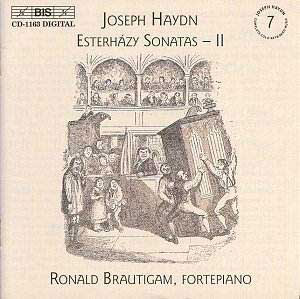Haydn composed prolifically during his thirty years
in the employ of the Esterházy family, and these sonatas reflect
his work at Eisenstadt in the early 1770s. Ronald Brautigam is an experienced
performer in the early classical repertoire, and he plays a fortepiano
made in 1992 by Paul McNaulty of Amsterdam, modelled on an example by
Anton Walter, dating from 1795.
The sound of the instrument and the style of the playing
are nothing if not authentic. In fact the artistry is such that the
enterprise soon seems entirely natural, both in terms of sound and tempi
and phrasing. Praise indeed.
The 'odd one out' among these four pieces is the earliest:
the C minor Sonata, because it was composed a little earlier than the
others (1771, not 1774). Stylistically this makes little difference,
but the nature of the development and the general organisation of the
music brings a more extended and open ended approach. The first movement
plays for a full twelve minutes, am astonishingly long time for a keyboard
movement in 1771. The reason for this is a classic example of Haydn's
admission that he 'was cut off from the world, and therefore forced
to be original'. For the basic sonata structure gives way to an interpolated
fantasia, to create a large and flexible form.
Brautigam is second to none in articulating such music
at an appropriate tempo, and this pays dividends in all the pieces recorded
here. The other three pieces - in D major, E flat major and A major
- were among a set of six published by Kurzbäck in Vienna in 1774
with the inscription: 'Six Sonatas for Prince Nikolaus Esterházy'.
Yet while they share the three movement construction in common, in truth
Haydn gives each its own identity, such is his evident genius.
The first movement of the D major Sonata is a classic
Haydn structure, to all intents and purposes monothematic in a rapid
3/4 time. The concluding Presto is a test for any pianist's dexterity,
a test Brautigam passes with flying colours.
The E flat Sonata has only two movements: Tempo Moderato
and Minuet, playing for some ten minutes in total. The first movement
has a certain formality, while the second lacks a central contrasting
trio and is therefore quite short. Brautigam again articulates the music
to perfection, but even he struggles to convince that this piece is
entirely successful
Th A major Sonata is notable for its wide ranging developments,
which Brautigam explores with tight articulation but subtle phrasing.
The Presto finale is astonishingly short, playing for a mere 44 seconds!
With a master such as Haydn, any new recording will
uncover riches, and so it proves here. While the music cannot rank among
the master's greatest works, it is full of imagination on every page,
and Brautigam is a sane and reliable guide. Full marks too should go
to the BIS engineers for their sensitive and atmospheric recorded sound.
Terry Barfoot


